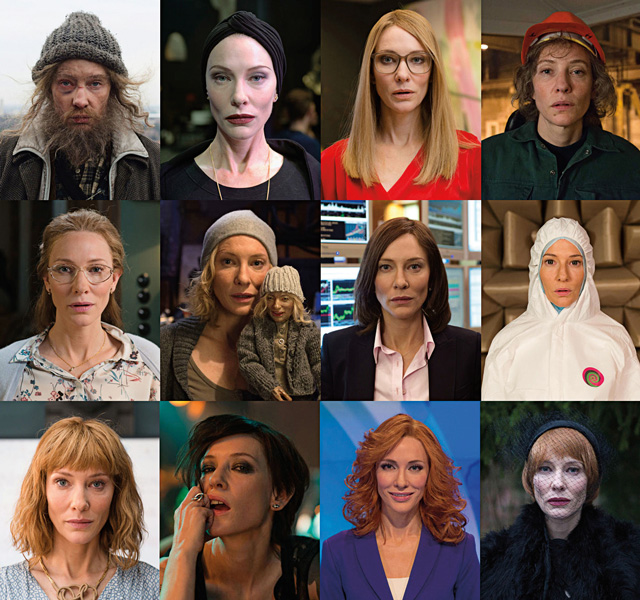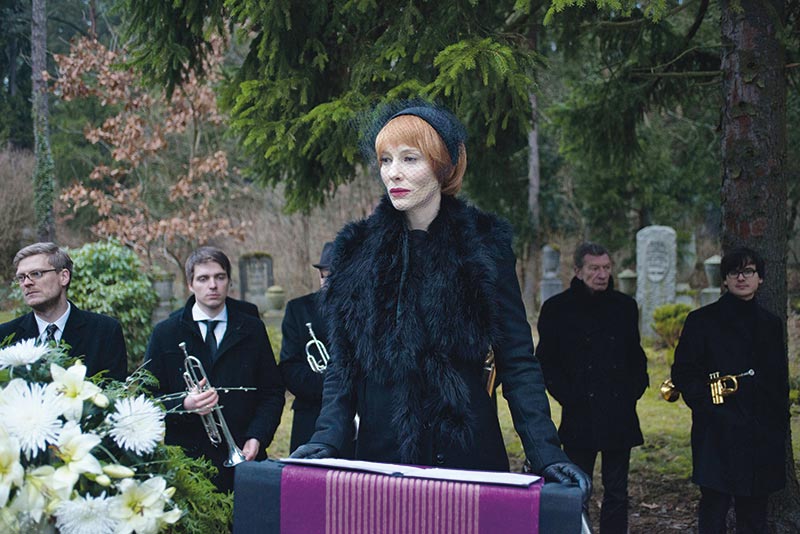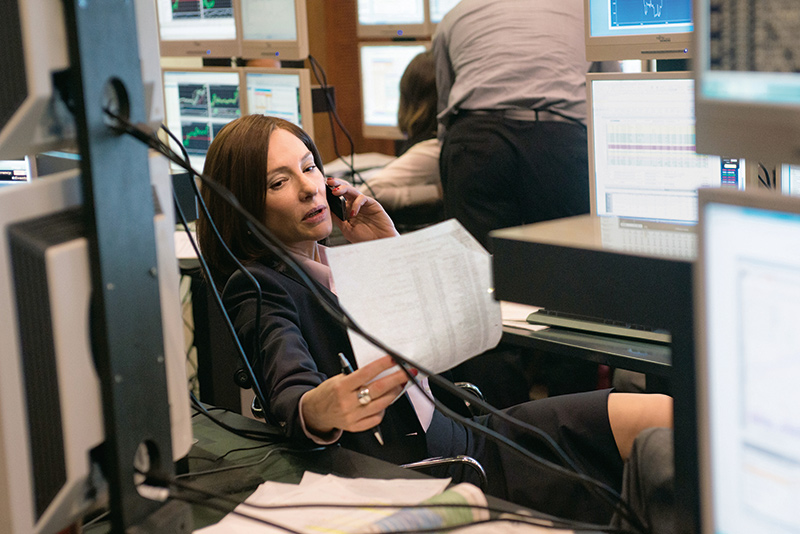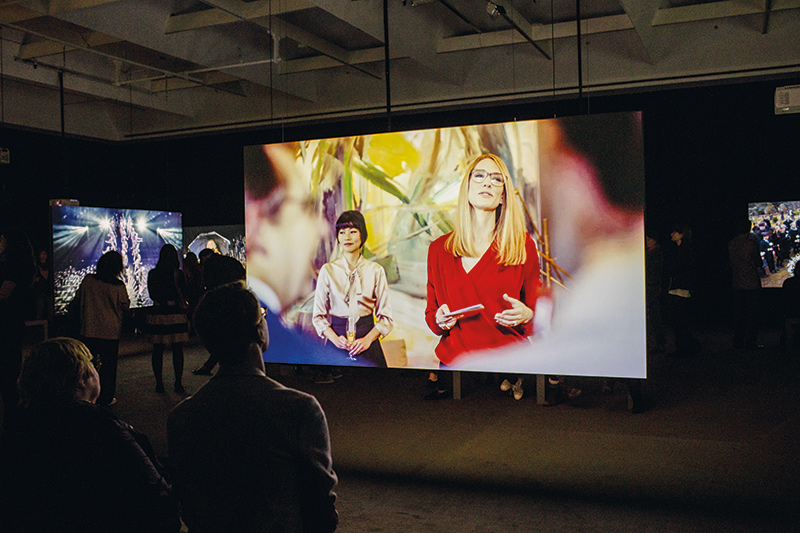[Summer 2019]
Musée d’art contemporain de Montréal
Oct. 20, 2018–January 20, 2019
By James Campbell
Whether playing a senior CIA agent (Hanna, 2011), Elf Queen Galadriel (The Lord of the Rings, 2001 2002, 2003), or a formerly rich New York socialite on the move (Blue Jasmine, 2013), Cate Blanchett has demonstrated her acting chops and established herself as one of the wiliest and most brilliant chameleons in contemporary cinema.
In Manifesto, a 2015 Australian-German multi-screen film installation in thirteen segments, each just over ten minutes long, scripted, produced, and directed by German video pioneer Julian Rosefeldt (b. 1965, Munich), Blanchett puts the megalopsychic capstone on her career to date with brio, audacity, and jaw-dropping verisimilitude. In each segment, she shines as she performs a different manifesto. Assuming personae as varied as teacher and puppeteer, news anchor and homeless man, Russian choreographer and trash incineration plant worker, Blanchett seduces her viewers effortlessly. She gives us a baker’s dozen of her most captivating performances to date. Each persona pays telling homage to the spirit and sensibility of one or more art manifestos.
Reciting lines such as Mierle Laderman Ukeles’s Fluxus-inspired “But after the revolution, who’s going to pick up the garbage on Monday morning?” Blanchett infuses her precisely enunciated narratives with provocation, punditry, and profundity. Sourcing the musings of individual artists, architects, dancers, filmmakers, such as Kazimir Malevich, Claes Oldenburg, Sol LeWitt, Elaine Sturtevant, Yvonne Rainer, and Jim Jarmusch and the writings of Futurists, Dadaists, Fluxus artists, Suprematists, Situationists, Dogma 95, and sundry other art groups, Rosefeldt and Blanchett together dilate on the role of the artist in a society on the edge. Their collaborative work here is timely and trenchant – and entirely unforeseen.
An actor of lesser gifts could never have embodied the manifestos so convincingly or adroitly. Blanchett transforms herself into a given manifesto. She owns it. One standouts is the video relating to Vorticism, Blue Rider, and Abstract Expressionism, in which Blanchett presents the idea for a new art endeavour to a small audience in her home. In another, she assumes the guise of a hirsute homeless man who strides across the rooftop of an abandoned factory like a character out of a play by Samuel Beckett, screaming out Guy Debord’s “Situationist Manifesto” at the lowering sky – she raises the hair on the nape of one’s neck. As a well-attired stockbroker sitting amidst computer monitors and expatiating at length about Futurism, a Surrealist puppeteer who recites lines from manifestos on Surrealism and Spatialism while putting flesh to her alter ego by making herself into a marionette, and in the dual role of announcer and on-site reporter who quizzes herself about Conceptualism and Minimalism in the precise cadences of the seasoned host, Blanchett leads us to suspend our disbelief. She becomes a scientist in a hazmat suit whose recitation from manifestos of Suprematism/Contructivism is halted by a monolith that closely resembles the one from Kubrick’s 2001: A Space Odyssey. As the orator ostensibly eulogizing the deceased at a funeral by reciting lines from Tristan Tzara’s “Manifeste de M. Antipyrine,” she treats us to lines such as, “Dada remains within the framework of European weaknesses, it’s still shit, but from now on we want to shit in different colours.”
Rosefeldt the writer and Blanchett the speaker redeem and elevate the language, imbuing it with gravitas, depth, and high drama. The different identities assumed segue with the expressions and exhortations of a given manifesto with nary a sliver of pretense – and it could so easily have devolved into pretense and falsity, after all – but with a certain humour and even, at times, overt silliness. Perhaps only an artist as non-hierarchical in her thinking and manner of working as Blanchett could pull this off.
Interestingly, Rosefeldt started this project by studying Karl Marx and Friedrich Engels’s The Communist Manifesto of 1848. He selected some sixty manifestos he found particularly provocative and reduced the final number to twelve segments, although most of the spoken texts are fragmented and collaged. His intention from the outset was to have a woman embody the manifestos and assume multiple roles. In choosing to work with Blanchett, he facilitated her wholesale descent into the time-binding oral cultural context of the art world. The flawless radiance of her performance is all the more remarkable given that the shoot, which took place in Berlin, was just eleven days long, and endless retakes were simply not possible.
The chorus of voices reaches the threshold of truly chiasmic dialogue in the large exhibition hall in which the works were presented. That chorus is, in a sense, an uber-manifesto, one that brings them all together and subsumes them under one rubric and, as it were, in the darkness binds them. One thing that marks most of the manifestos is that they were written when the authors were still young. They have fire in them, and the explosive ejaculations of words here remind us that the manifesto exists to animate, incite, and give birth to a new future in which the old orthodoxies are cast down and replaced by new and better models.
The manifesto here is best understood as a protreptic – in the sense of oration used to persuade or instruct. In this work, they also serve an emotional purpose: to turn a key in the padlock of the human heart and mind and to inscribe new priorities. As is the case with ancient philosophical protreptics, the spoken fragments of manifestos have a didactic function freed from their original context. The order of words itself is antidote and incitement, lit fuse and fervent injunction, never anodyne. All the spoken words here point to the universal role that artists still play as revolutionary agents in our society.
James D. Campbell is a writer and curator who writes frequently on photography and painting from his base in Montreal.
[ Complete issue, in print and digital version, available here: Ciel variable 112 – COLLECTIONS REVISITED ]
[ Individual article in digital version available here: Julian Rosefeldt — James Campbell ]




